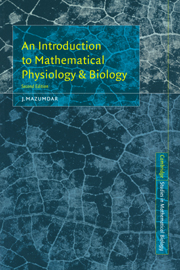Book contents
- Frontmatter
- Contents
- PREFACE TO THE SECOND EDITION
- PREFACE TO THE FIRST EDITION
- Chapter 1 DIMENSIONAL ANALYSIS IN MATHEMATICAL PHYSIOLOGY
- Chapter 2 THE MATHEMATICS OF DIFFUSION
- Chapter 3 POPULATION BIOLOGY
- Chapter 4 BIOGEOGRAPHY: MATHEMATICAL ANALYSIS OF WILDLIFE RESERVES
- Chapter 5 PHARMACOKINETICS: DRUG DISTRIBUTION IN PHARMACOLOGY
- Chapter 6 MATHEMATICAL MODELLING IN EPIDEMIOLOGY
- Chapter 7 MODELLING THE AIDS EPIDEMIC
- Chapter 8 BIOLOGICAL FLUID MECHANICS
- Chapter 9 ANALYSIS AND APPLICATIONS OF LEFT VENTRICULAR MECHANICS
- Chapter 10 ANALYSIS AND APPLICATIONS OF HEART VALVE VIBRATION
- Chapter 11 MEDICAL DEVICES
- GLOSSARY OF TERMS
- REFERENCES
- INDEX
Chapter 4 - BIOGEOGRAPHY: MATHEMATICAL ANALYSIS OF WILDLIFE RESERVES
Published online by Cambridge University Press: 05 June 2012
- Frontmatter
- Contents
- PREFACE TO THE SECOND EDITION
- PREFACE TO THE FIRST EDITION
- Chapter 1 DIMENSIONAL ANALYSIS IN MATHEMATICAL PHYSIOLOGY
- Chapter 2 THE MATHEMATICS OF DIFFUSION
- Chapter 3 POPULATION BIOLOGY
- Chapter 4 BIOGEOGRAPHY: MATHEMATICAL ANALYSIS OF WILDLIFE RESERVES
- Chapter 5 PHARMACOKINETICS: DRUG DISTRIBUTION IN PHARMACOLOGY
- Chapter 6 MATHEMATICAL MODELLING IN EPIDEMIOLOGY
- Chapter 7 MODELLING THE AIDS EPIDEMIC
- Chapter 8 BIOLOGICAL FLUID MECHANICS
- Chapter 9 ANALYSIS AND APPLICATIONS OF LEFT VENTRICULAR MECHANICS
- Chapter 10 ANALYSIS AND APPLICATIONS OF HEART VALVE VIBRATION
- Chapter 11 MEDICAL DEVICES
- GLOSSARY OF TERMS
- REFERENCES
- INDEX
Summary
Basic Concepts
The study of biogeography is predominantly concerned with conserving or determining the maximum number of species possible on an island. This is achieved through setting up mathematical models, both static and dynamic, whose parameters have been experimentally evaluated and statistically tested. These parameters will usually be assumed to be constant so as to enable easier deductions from the models from some of the more important variables. These include the number of species, area of the island and, for the dynamic models, immigration and extinction rates. Islands are simpler than continents and by examining them in clusters we may gain insight into the more complex topic of continental biogeography. Also, evolutionary hypotheses are more easily tested on islands as evolution is more likely to take place more rapidly in small isolated populations.
Because of the sizeable number of islands and their varied shapes and sizes they lend themselves to statistical survey and hence may facilitate the use or building of mathematical models. The number of species on different islands may vary considerably and this is due to a number of influences.
There may be problems of access: oceans, for example, may create barriers for nonflying organisms. Larger islands will usually support more species as they will contain a larger variety of habitats than the smaller islands.
An island isolated from the mainland is less likely to have a large variety of life than a closer island and the richness of the mainland source will also affect this variety.
- Type
- Chapter
- Information
- An Introduction to Mathematical Physiology and Biology , pp. 69 - 89Publisher: Cambridge University PressPrint publication year: 1999



